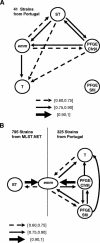Illustration of a common framework for relating multiple typing methods by application to macrolide-resistant Streptococcus pyogenes
- PMID: 16825375
- PMCID: PMC1489512
- DOI: 10.1128/JCM.02536-05
Illustration of a common framework for relating multiple typing methods by application to macrolide-resistant Streptococcus pyogenes
Abstract
The studies that correlate the results obtained by different typing methodologies rely solely on qualitative comparisons of the groups defined by each methodology. We propose a framework of measures for the quantitative assessment of correspondences between different typing methods as a first step to the global mapping of type equivalences. A collection of 325 macrolide-resistant Streptococcus pyogenes isolates associated with pharyngitis cases in Portugal was used to benchmark the proposed measures. All isolates were characterized by macrolide resistance phenotyping, T serotyping, emm sequence typing, and pulsed-field gel electrophoresis (PFGE), using SmaI or Cfr9I and SfiI. A subset of 41 isolates, representing each PFGE cluster, was also characterized by multilocus sequence typing (MLST). The application of Adjusted Rand and Wallace indices allowed the evaluation of the strength and the directionality of the correspondences between the various typing methods and showed that if PFGE or MLST data are available one can confidently predict the emm type (Wallace coefficients of 0.952 for both methods). In contrast, emm typing was a poor predictor of PFGE cluster or MLST sequence type (Wallace coefficients of 0.803 and 0.655, respectively). This was confirmed by the analysis of the larger data set available from http://spyogenes.mlst.net and underscores the necessity of performing PFGE or MLST to unambiguously define clones in S. pyogenes.
Figures




References
-
- Beall, B., R. R. Facklam, J. A. Elliott, A. R. Franklin, T. Hoenes, D. Jackson, L. Laclaire, T. Thompson, and R. Viswanathan. 1998. Streptococcal emm types associated with T-agglutination types and the use of conserved emm gene restriction fragment patterns for subtyping group A streptococci. J. Med. Microbiol. 47:893-898. - PubMed
-
- Billal, D. S., M. Hotomi, K. Yamauchi, K. Fujihara, S. Tamura, K. Kuki, R. Sugita, M. Endou, J. Mukaigawa, and N. Yamanaka. 2004. Macrolide-resistant genes of Streptococcus pyogenes isolated from the upper respiratory tract by polymerase chain reaction. J. Infect. Chemother. 10:115-120. - PubMed
-
- Carriço, J. A., F. R. Pinto, C. Simas, S. Nunes, N. G. Sousa, N. Frazão, H. de Lencastre, and J. S. Almeida. 2005. Assessment of band-based similarity coefficients for automatic type and subtype classification of microbial isolates analyzed by pulsed-field gel electrophoresis. J. Clin. Microbiol. 43:5483-5490. - PMC - PubMed
Publication types
MeSH terms
Substances
Grants and funding
LinkOut - more resources
Full Text Sources

